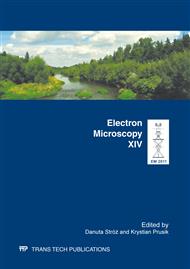p.16
p.20
p.24
p.28
p.32
p.37
p.41
p.45
p.49
Physical and Chemical Studies of Bacterial Bioaerosols at Wastewater Treatment Plant Using Scanning Electron Mikroscopy and X-Ray Photoelectron Spectroscopy
Abstract:
The paper presents the research results of the airborne bacteria collected at the wastewater treatment plants working with activated sludge system. Samples were taken by a six-stage Andersen Impactor placed near the aeration chambers. Bacteria cought at Petri plates were incubated at room temperature for 4 days, then analyzed in a macroscopic and microscopic way. This initial investigation was aimed at morphological characteristics of colonies and breeding characteristics of particular strains to giver general overwiev. Bacteria were identified on the basis of their metabolic properties using API biochemical tests. The essential studies were carried out using JOEL scanning electron microscope (FE-SEM model with field gun 7600[F]), equipped with "Cryo-SEM”, which gives the possibility of testing delicate biological samples in a frozen state. Its high resolving power and large depth of field allows to obtain images of surface structure of microorganisms in a magnification range from 1 000x to 70 000x. Bacteria samples were analyzed also in a fructured state what revealed internal structes and the thickness of cell walls which was in the range of 0,080-0,180 [μm]. Moreover, elemental composition of the surface layer of bacterial was also examined using photoelectron spectroscopy (XPS). Dominant elements were carbon, oxygen and nitrogen. Analysis of main line (C1s, O1s, N1s) allowed the identification of chemical composition of studied bioaerosols. Investigation found that the main compounds were polymers such as peptides and polysaccharides, as well hydrocarbon like compounds.
Info:
Periodical:
Pages:
32-36
Citation:
Online since:
March 2012
Price:
Сopyright:
© 2012 Trans Tech Publications Ltd. All Rights Reserved
Share:
Citation:


